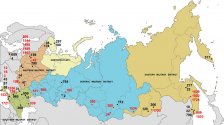I am going through an analysis of Russian WKS in my spare time and here's what I've got:
Russian cumulative plans for aircraft production for the period of 2010-2020 were as follows:
- approx. 128 new Su-35 - aircraft manufactured after 2010
- approx. 90 new Su-30SM and 20 new Su-30M2 - aircraft manufactured after 2010
- approx. 122 new Su-34 - aircraft manufactured after 2010
- approx. 80-120 modernized Su-25 - aircraft manufactured in late 80s /early 90s
- approx. 80-120 modernized MiG-31 - aircraft manufactured 1990-1994
Currently the plans for modernization are as follows:
- all of Su-30SM will be modernized to SM2 standard which involves radar, avionics and engines from Su-35
- all of Su-34 will be modernized to M standard and 76 new Su-34M will be produced by 2027
- 76 new Su-57 will be produced by 2028
Now with regards to the forces distribution:
View attachment 74844
Black are aviation units excluding long range aviation. Red are missile units.
Both missile and long range aviation units are not included in the listing below:
View attachment 74845
The primary types of units
seem to be:
- interceptor squadron in a fighter regiment - MiG-31BSM (currently BS/BM being modernized)
- fighter squadron in a fighter regiment - Su-35S (currently some operate Su-27SM and Su-27SM3)
- multirole squadron in a fighter or attack regiment - Su-30SM (currently some operate Su-24M)
- attack squadron in a bomber regiment - Su-34 (currently some operate Su-24M)
- recon and EW squadron in a mixed or recon regiment - Su-24MR (to be replaced by Su-34M)
- attack squadron in an attack regiment - Su-25SM3 (currently Su-25SM)
In the tables you should assume 12-13 combat aircraft of the above mentioned types to be the intended figure. Su-30M2 serve as training aircraft as are some Su-30SMs.
This will translate to three kinds of military districts in terms of air force composition:
- two "defensive" districts in which Russia assumes a strategic defensive posture - Western and Eastern - with a regiment of interceptors augmented by a squadron of fighters (2xMiG-31BSM, 1x Su-35), a regiment of fighters (Su-35), multirole (Su-30SM), bombers (Su-34M) and a squadron of recon/EW (Su-34M).
- one "offensive" district in which Russia wants to retain strategic initiative - Southern - with a similar structure to "defensive" districts but with greater number of bomber and attack units.
- two "patrol" districts in which Russia assumes control of airspace - Central and Northern - with a regiment of interceptors (MiG-31) and regiment of bombers/recon planes (Su-34M)
The large number of Su-25s in the Eastern district might be misleading. They simply need to be there because Su-25s units from Southern district can easily be moved to Central or Western if necessary due to distances involved.
Altogether Russians will have:
- approx. 126 MiG-31BSM
- approx. 90 Su-30SM
- approx. 128 (or more) Su-35S
- approx. 198 Su-34M
- approx. 108 Su-25SM3
Of those only MiG-31 and Su-25 have limited airframe life and are being modernized to serve until 2030. There is not a lot of space for more 5th gens and it doesn't exactly fit with Russian air combat doctrine so far. Perhaps after 2030 but not in the upcoming decade.
This leaves us with the 5th gen that's already here:
I have no idea where Su-57s will go but it seems that Russians themselves are not certain yet. It terms of numbers there are two logical solutions:
- some Su-30SM will be moved to attack units - especially Naval Aviation - and Su-57s will be directed to fighter duties in that area since they have greater capabilities in air control compared to even the "mini AWACS" Su-30. This should be most evident in Southern district.
- some MiG-31BSM will be withdrawn to reserve and Su-57s will augment interceptor units. This is based on the tests that the aircraft have gone through in one of the MiG-31 bases. It is also consistent with some of the mission profile for Su-57 and MiG-31.
76 aircraft means 72 for three regiments +4 for test and training units. Three regiments can be split into six squadrons in mixed regiments but Eastern, Western and Southern districts require a regiment-equivalent in terms of numbers. Northern doesn't really need Su-57s because atmospheric conditions call for a more robust plane (hence MiG-31) and Central is not likely to become a high threat area in the upcoming decade.
As for future potential:
Note that Russia made a conscious decision to continue the development of Su-27 family and discontinue the MiG-29s. This is not a preference for a company but preference for capabilities. Russia needs large planes because large planes have range and payload. Russia is HUGE. Su-34 have combat radius of 1000-2000km depending on the payload. Su-30/35s have combat radius of 1200-1500 with air-to-air loadout. MiG-31 is in service is because it has similar combat radius and the ability to cruise(!) at 2+ Ma. It's all about the ability to control and secure space to deny it to the enemy for maneuver. An aircraft such as F-35 is just
too small. It means Russia would have to have more of them and since they are expensive and difficult to manufacture it just doesn't make sense. All the expensive elements in a 5th gen are marginally more expensive in a large one compared to a small one. This is why I don't see Russia developing a smaller 5-th gen unless it's for short-range strike missions or export. For strike missions Russia could do better with stand-off and rocket artillery. But for export - it actually plays a lot into long-term strategy. If they somehow manage to manufacture a cheap 5th-gen-equivalent they can shut out not just Americans but potentially China as well.
My conclusion would be that Russia in the future dominated by US-China rivalry will play the same role as France had during the US-USSR rivalry. If you know what the French did you know what I mean. As long as they keep nukes and maintain space capability as well as the other primary strategic deterrent in the "soft" area (intelligence, cyber, spec-ops, bio) that is easily the most viable solution for a successful long-term game in the 21st century. Anything else and they will crumble under pressure from stronger opponents east or west.


